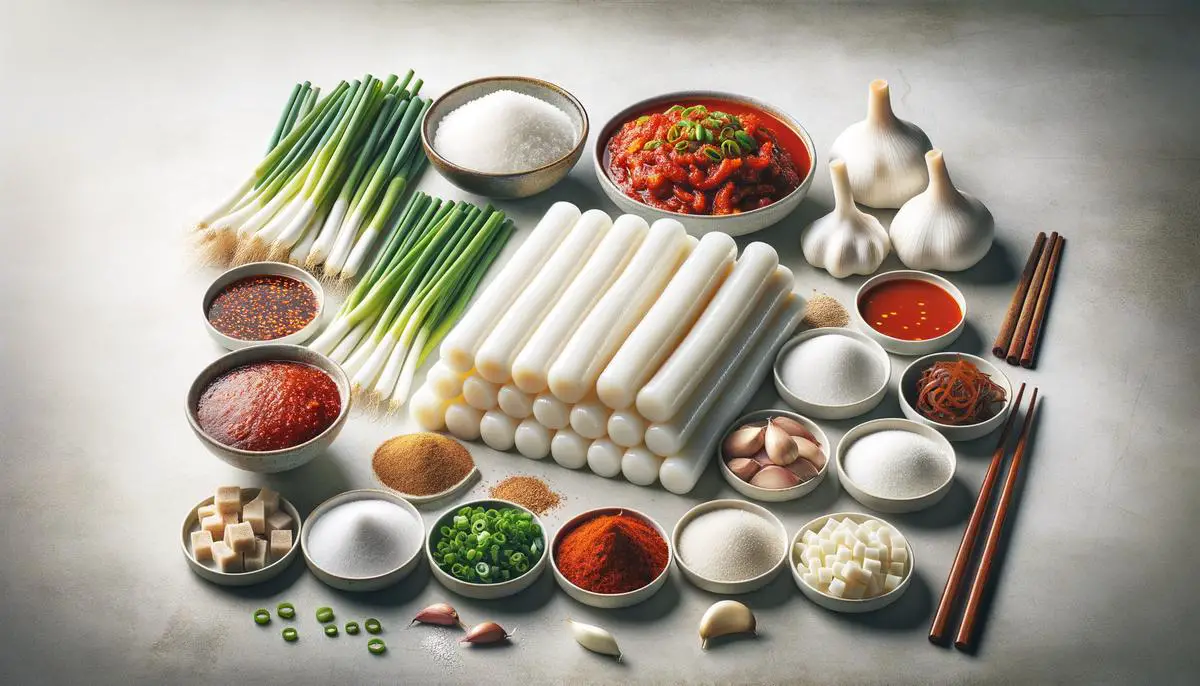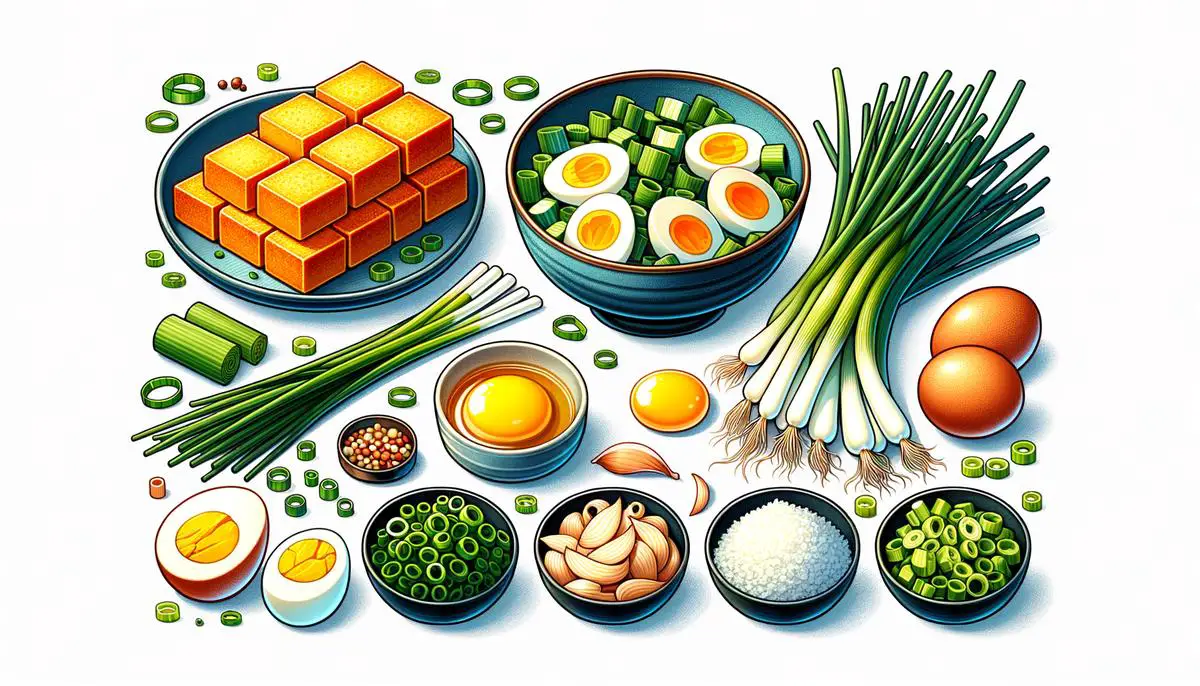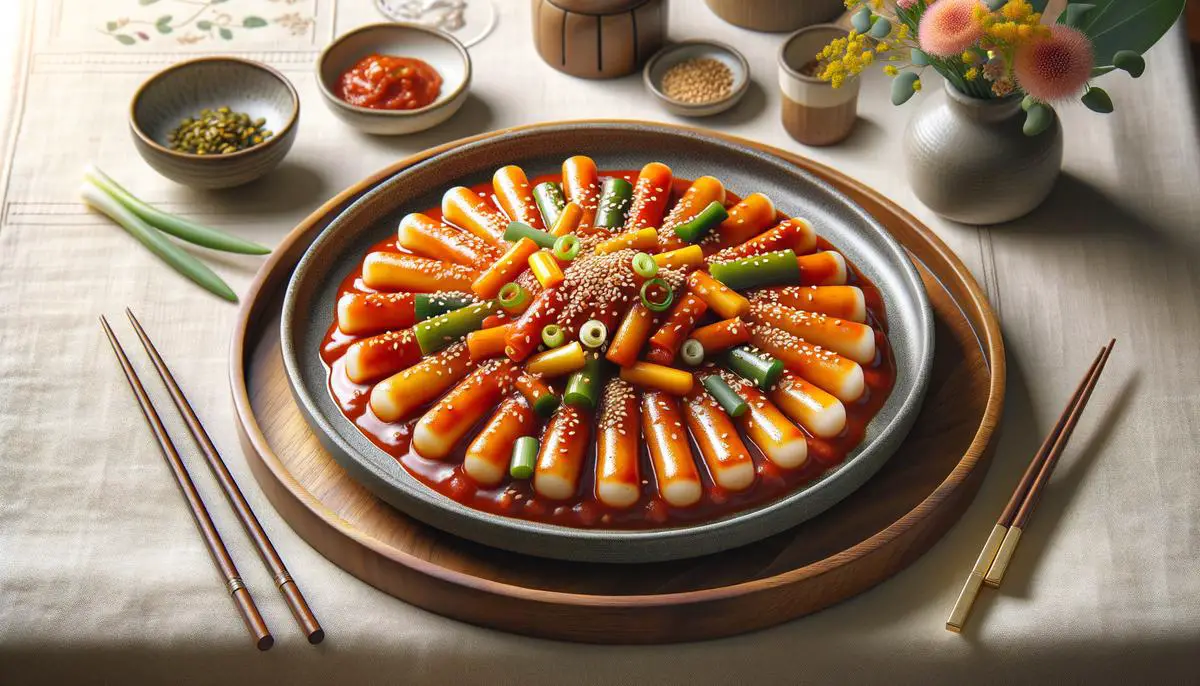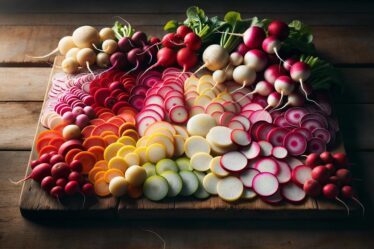
Creating the perfect Tteokbokki, a favorite Korean street food, is all about finding and preparing the right ingredients. This article will guide you through selecting top-quality rice cakes and gochujang, along with other essentials to bring out the authentic flavors of this dish. With tips on sourcing and preparation techniques, you’re on your way to making an exquisite Tteokbokki that captures both tradition and personal taste.
Sourcing Ingredients
Finding the ideal ingredients for Tteokbokki, a beloved Korean street food dish, mainly revolves around tracking down top-notch rice cakes (tteok) and gochujang (Korean chili paste). These are central to achieving that authentically spicy and slightly sweet flavor. Here’s how you can source these ingredients like a pro.
Rice Cakes (Tteok)
You might think acquiring the best rice cakes requires a ticket to Seoul. However, unexpectedly high-quality tteok can be found closer to home, if you know where to look.
Asian Markets: Start your hunt at local Korean or broader Asian grocery stores. These markets often have a refrigerated section devoted to fresh rice cakes. You’re searching for tteok that has a soft, yet chewy texture — and avoid anything that feels too hard or dry. If the variety overwhelms you, ask for “tteokbokki tteok,” which are the cylindrical rice cakes meant explicitly for this dish.
Online Retailers: If your local grocery store falls short, online can fill the gap. Platforms like Amazon and specialty sites sell dried or frozen rice cakes. Reviews are your friend here; they can guide your purchase to ensure you get that coveted chewy consistency.
Gochujang (Korean Chili Paste)
Gochujang brings the defining spicy-sweet depth to Tteokbokki. Its quality can range significantly, so focusing on a few key features will help you avoid disappointment.
Ingredient Lists Matter: Peek at the label — a short ingredient list usually indicates higher quality. Traditionally, gochujang consists of chili powder, fermented soybeans, glutinous rice, and salt. Steer clear of versions with corn syrup or a multitude of preservatives.
Local Korean Grocery Store: Again, these markets are invaluable. They often carry gochujang ranging from mild to inferno-level heat. Start with a medium heat to suit most palates and adjust according to your taste preference.
Online Korean Specialty Stores: For those who want the real deal without hopping on a plane, numerous online Korean grocery stores offer authentic gochujang made in Korea. These are typically crafted using traditional methods and promise an unbeatable depth of flavor.
Final Tips
Remember, the magic of Tteokbokki doesn’t just lie in the rice cakes and gochujang. It’s about balancing flavors, so feel free to experiment with additions like sugar, soy sauce, or even a splash of broth.
And there you have it — your guide to securing the pillars of an exquisite Tteokbokki dish right from the comfort of your city. Happy cooking!

Preparation Techniques
Preparing Your Tteokbokki Ingredients for a Flawless Dish
In the realm of Tteokbokki, two protagonists—rice cakes and gochujang—dominate the storyline. Yet, a cast of supporting characters magnifies their performance. Fish cakes, boiled eggs, and green onions not only add layers of taste but also an exquisite textural contrast that defines a masterful Tteokbokki. Here’s how to prep these essential elements to elevate your dish from good to unparalleled.
Fish Cake: An Unassailable Umami Kick
- Select wisely: Thin rectangular sheets, often found in frozen sections at Asian markets, are your target. Opt for ones boasting minimal additives for a pristine taste.
- Prep for success: Thaw and slice the fish cakes into desirable strips or shapes. A diagonal cut not only augments the aesthetic but ensures more surface area for absorbing the sauce.
- Blanche, then plunge: Briefly blanch these slices in boiling water for about 30 seconds to remove excess oil and potential odors. Immediately plunge them into cold water, drain and set aside. This step guarantees a cleaner taste profile.
Boiled Eggs: A Creamy Contradiction
- Boil to perfection: Aim for ‘jammy’ eggs—a fudgy yolk rimmed by fully set white. Achieve this by boiling the eggs for exactly 6 minutes and 50 seconds (timers at the ready), before transferring them to an ice-water bath.
- The peeling game: Once cool, tap the eggs gently on the counter, and roll to crack the shell. Begin peeling at the wider end—where air pockets reside—for ease. Rinse off any remaining shell shards under cold water.
Green Onions: The Crisp Finale
- Choose wisely: Look for bright, firm green stalks with no signs of wilting. These are your fresh, crisp finishers.
- The julienne journey: Wash thoroughly, then slice finely at an angle. These slivers not only garnish but inject a fresh, almost spicy zest into your Tteokbokki, balancing the heavy umami tones.
Assembly: Harmony in Chaos
Each component holds its essence, waiting to meld in the final act. The moment has arrived to unite them with your principal ingredients. As the rice cakes and gochujang stew come together, introduce the fish cakes and carefully halved boiled eggs into your concoction.
Stir gently, simmering with anticipation—a scant few minutes from completion, sprinkle your green onion slivers atop. They should barely wilt in the heat, maintaining their crisp demeanor.
Voilà: you’ve conjured a Tteokbokki that’s balanced yet complex, weaving through the spectrum of textures and flavors with the precision of a conductor leading an orchestra. The stage is set; the curtain rises on a meal that resonates with depth, spiciness, and undeniable charm.

Cooking Process
In the labyrinthine world of Tteokbokki, the secret sauce—literally—is often what elevates your dish from average street food fare to a sublime culinary experience. Venturing beyond the basics of top-notch ingredients like high-grade rice cakes and meticulously chosen gochujang, let’s dive into achieving that perfect harmony of flavors and texture, making your Tteokbokki not just good, but mesmerizing.
Precision in Proportions
Balancing the components of your sauce is paramount. The ideal ratio of gochujang to liquid (be it water, broth, or a mix thereof) should be about 1:4. Adjust this according to the desired thickness and intensity of flavor. Remember, the sauce should cling tenderly to the rice cakes, not drown them.
Don’t eyeball this; achieving sauce nirvana requires precision—a little too much or too little of one element and you’ve missed the mark. Use measuring spoons and cups or, better yet, a kitchen scale. It may feel clinical for a dish steeped in homeliness, but precision pays off.
A Slow Simmer
Patience is more than a virtue in cooking; it’s often the dividing line between mediocrity and magnificence. Once your Tteokbokki is assembled, resist the urge to crank up the heat for a quicker conclusion. A gentle simmer allows flavors to meld beautifully while ensuring your rice cakes absorb the sauce, becoming plush and tender without disintegrating.
Keep it on low. Occasional stirring is key to prevent sticking and ensure even cooking. Watch as the sauce gradually thickens to a glossy veneer that generously coats every piece.
The Taste Test
Our palates are as unique as fingerprints, which means adjusting flavors as you cook is not just recommended, it’s essential. Midway through simmering, take a moment to taste your Tteokbokki. Too bland? A pinch of salt or a dash of soy sauce can work wonders. Overwhelming heat? A spoonful of sugar or honey might be just the remedy.
Embrace the role of taste-tweaker diligently. In the alchemy of Tteokbokki, your personal taste dictates the final product more than any recipe could.
The Element of Surprise
The quintessence of mesmerizing Tteokbokki lies in an unexpected twist—a secret ingredient that intrigues and delights. Contemplate adding a splash of mirin for subtle sweetness and depth or a sprinkle of roasted sesame seeds for a nutty finish. Consider introducing a sliver of cheese over the top during the last few minutes of cooking for a gooey, creamy texture that’s unorthodox but undeniably indulgent.
Experiment with one novel ingredient at a time to gauge its impact. The goal is to enhance, not overshadow, the foundational flavors of your dish.
Presentation as Persuasion
Finally, visual appeal is your silent salesman, whispering promises of deliciousness before the first bite is taken. Invest a moment to plate your Tteokbokki beautifully. Garnish with a final sprinkle of sliced green onions or a delicate swirl of sesame oil for that enticing sheen. Even in the simplicity of street food, the eyes feast first.
In closing, making Tteokbokki that captivates both the palate and the eye isn’t about adhering slavishly to tradition nor about extravagantly deviating from it. It’s about mastering fundamentals and then daring to leave your signature through subtlety and balance. Thus prepared, your Tteokbokki transcends from merely being a dish to becoming an experience—a mesmerizing one at that.

Making Tteokbokki that stands out isn’t just about following a recipe; it’s about understanding the harmony between ingredients and how slight tweaks can elevate the dish to new heights. By focusing on quality ingredients, precise proportions, and personal touches in flavor adjustment and presentation, you create not just a meal but an experience. This approach ensures your Tteokbokki is not only visually appealing but also rich in depth and flavor, leaving a memorable impression on anyone who tastes it.



